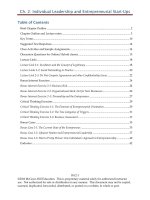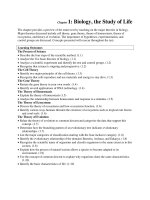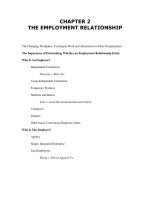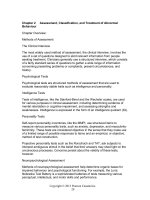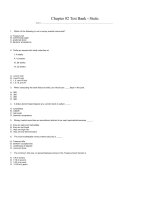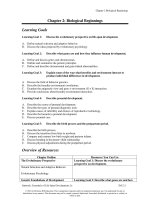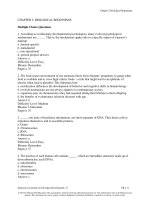Test bank and solution manual of ch02 the chemist tool box (1)
Bạn đang xem bản rút gọn của tài liệu. Xem và tải ngay bản đầy đủ của tài liệu tại đây (172.86 KB, 9 trang )
CHAPTER 2
THE CHEMIST’S TOOL BOX
ANSWERS TO QUESTIONS:
1. Curiosity is an important part of the scientific enterprise because scientists need a strong
desire to investigate and learn about the behavior of nature. Science must start with the
question why. The scientific method is then utilized to accumulate systematized knowledge
about the physical world. A scientist’s curiosity is incapable of being satisfied. Without the
curious nature of scientists, the advancement of science would not have occurred as we
presently know it.
2. Science is characterized by observations, which are used to develop experimental laws and
theories for the workings of nature. Measurement lies at the heart of experiment. Nature
appears to be based on a foundation that can be described by mathematics, and measurements
provide the bricks to build upon this foundation.
3. Measured quantities are written so that the uncertainty is contained within the last digit of the
number. A volume of 30.0 mL means the volume lies in the range 29.9 – 30.1 mL (30.0 ±
0.1 mL).
4. The difference between the quantities 9 inches and 9.00 inches is the amount of certainty or
precision. Although numerically equivalent (the results of using 9 inches or 9.00 inches in a
calculation will be indistinguishable), 9 inches tells us it is only certain in the range 8 – 10
inches; the quantity 9.00 inches is much more precise, having a certainty in the much
narrower range of 8.99 – 9.01 inches.
5. Any measurement consists of a numerical value and the chosen unit. Units inform what is
being measured and the scale used. Without a unit, a measurement is virtually useless. For
example, if I say it is thirty degrees outside, the response will be thirty what? An American
would presume it is cold since he is familiar with Fahrenheit; a European would turn on the
air-conditioning presuming the measurement to be in Celsius. In science the International
System of units, or SI, is generally used.
6. Answers may vary. Three possible units for length are millimeters, centimeters and meters.
Examples:
Thickness of a dime - millimeters (mm)
Length of a finger - centimeters (cm)
Height of an adult - meters (m)
7. Answers may vary. Three possible units for length are grams, milligrams and kilograms.
Examples:
Mass of a penny - grams (g)
Mass of a straight pin - milligrams (mg)
Mass of a bucket of water - kilograms (kg)
10
Chemistry in Focus, 5th edition
Tro
8. Answers may vary. Three possible units for time are milliseconds, seconds, and
microseconds.
Examples:
Time between heartbeats - milliseconds (ms)
Time to run the 100 m. dash - seconds (s)
Time to blink your eye - microseconds (s)
9. Answers may vary. Three possible units for volume are milliliters, kiloliters (gallons), and
liters.
Examples:
Volume of a child’s juice box – milliliters (mL)
Volume of water in a swimming pool – gallons or kiloliters (kL)
Volume of a bottle of soda – liters (L)
10. A conversion factor is an equivalence statement that relates one unit to another. Conversion
factors are commonly written in equation form or as a fraction with units in the numerator
and denominator. Because it is an equivalence statement, the fraction equals one and the
conversion factor can be multiplied by any number with out changing the value of the
number, only its units.
11. Graphs are a very convenient and powerful way to illustrate relationships between different
quantities. Graphs can be modified to emphasize particular features. It is important to
examine the range on the y axis to understand the significance of the changes plotted. A
change will look much bigger if the scale is smaller, whereas a small change on a large scale
could go virtually unnoticed.
12.
a) The decimal part of the number is 9.66
b) The exponential part of the number is 10-5
c) The exponent is -5.
13. Density is defined as mass per unit volume. Typical units for density are g/cm3 (commonly
used for solids) and g/mL (used for liquids)
14. Oil floating on water means that the density of the oil is less than that of the water. Denser
substances will sink in less dense substances.
SOLUTIONS TO PROBLEMS:
15.
a)
8.51 x 10-4 g
b)
3.6961664 x 107
c)
2.9979 x 108 m/s
d)
3.0700655 x 108
11
Chapter 1
16.
Instructor’s Manual
a)
1.9541453 x 107
b)
6.873370698 x 109
c)
7.461 x 10-11 m
d)
1.5 x 10-5 m
a)
149,000,000 km
b)
0.000000000079 m
c)
4,540,000,000 yr
d)
6,400,000 m
a)
602,200,000,000,000,000,000,000 carbon atoms in 12.01 grams of carbon
b)
299,000,000 m/s
c)
0.000000450 m
d)
13,700,000,000 yr
17.
18.
19.
a) 4.0075 x 107 m
40075 km 1000 m
4.0075x10 7 m
1
1 km
b) 24,900 or 2.490 x 104 mi to 4 significant figures
c) 1.3149 x 108 ft
40075 km 0.6214 mi
2.490x10 3 mi
1
1 km
40075 km 0.6214 mi 5280 ft
1.3149x10 8 ft
1
1 km
1 mi
20. Convert 2,777 miles into a) kilometers, b) meters, c) feet.
12
a) 4469 km
2777 mi
1 km
2777 mi x 1 km
4,469 km
=4469 km
1
0.6214 mi
0.6214 mi
b) 4.469 x 106 m
2777 mi
1 km
1000 m
4.469x10 6 m
1
0.6214 mi 1 km
c) 1.466 x 107 ft
2777 mi 1760 yd 3 ft
1.466x10 7 ft
1
1 mi
1 yd
Chemistry in Focus, 5th edition
21. 12 oz is 355 mL.
Tro
12 oz 1 qt 1 gal 3.785 L 1000 mL
355 mL
1
32 oz 4 qt
1 gal
1L
22. 150 mL is 5.07 oz.
150 mL
1L
1.057 qt 32 oz
5.07 oz
1
1000 mL
1L
1 qt
23. Convert miles to kilometers: 1 km = 0.6214 mi .
27 mi
1 km
43 km
1
0.6214 mi
Efficiency is 43 km/gal
24. Convert kilometers to miles: 1 km = 0.6214 mi
17 km 0.6214 mi
11 mi
1
1 km
Car will travel 11 miles on one liter of fuel.
25.
a)
b)
c)
d)
4332 mm
1m
4.332 m
1
1000 mm
1.76 kg 1000 g
1,760 g
1.76 kg = 1760 g or 1.76 x 103 g
1
1 kg
4619 mg
1g
1 kg
4.619x10 -3 kg
4619 mg = 4.619 x 10-3 kg
1
1000 mg 1000 g
0.0117 L 1000 mL
11.7 mL
0.0117 L = 11.7 mL
1
1L
4332 mm = 4.332 m
26.
a) 2319 cm = 23.19 m
b) 4912.5 g = 4.9125 kg
c) 23.1 cm = 231 mm
d) 561 mL = 0.561 L
2319 cm
1m
23.19 m
1
100 cm
4912.5 g 1 kg
4.9125 kg
1
1000 g
23.1 cm 10 mm
231 mm
1
1 cm
561 mL
1L
0.561 L
1
1000 mL
13
Chapter 1
Instructor’s Manual
27.
358 m 39.37 in 1ft
1170 ft
12in
1
1m
10 km 0.6214 mi
6.21 mi
1
1 km
1.55 m 39.37 in
61.0 in
1
1m
23 cm
1 in
9.1 in
1
2.54 cm
a)
358 m = 1170 ft (or 1.17 x 103 ft)
b)
10.0 km = 6.21 mi
c)
1.55 m = 61.0 in
d)
23 cm = 9.1 in
a)
4.92 in = 125 mm
b)
8779 yd = 8.026 km
8779 yd
1 mi
1mi
8.026 km
1
1760 yd 0.6214km
1m
87 ft 12 in
27 m
87 ft = 27 m
1
1 ft 39.37 in
3.8 in 2.54 cm
9.7 cm
3.8 in = 9.7 cm
1
1 in
28.
c)
d)
4.92 in 25.4 mm
125 mm
1
1 in
29.
a) 1552 m2 = 1.339 x 104 ft2
1552 m 2 (39.37 in) 2
1 ft 2
1.671x10 4 ft 2
1
1m2
(12 in) 2
b) 1552 m2 = 1.552 x 10-3 km2
1552 m 2
1 km 2
1.552x10 -3 km 2
1
(1000 m) 2
c) 1552 m2 = 1.552 x 105 dm2
1552 m 2 (10 dm) 2
1.552x10 5 dm 2
2
1
1m
30.
a) 54 cm3 = 5.4 x 104 mm3
b) 54 cm3 = 3.8 in3
3
-2
3
c) 54 cm = 5.4 x 10 dm
14
54 cm 3 (10 mm) 3
5.4x10 4 mm 3
3
1
1 cm
3
54 cm
1 in 3
3.3 in 3
3
1
(2.54 cm)
54 cm 3
1 dm 3
5.4x10 -2 dm 3
3
1
(10 cm)
Chemistry in Focus, 5th edition
31.
31.
32.
Tro
a) 1 square kilometer (km2) = 106 square meters (m2). (1 km = 103 m)
1 ft 3 (12 in) 3 (2.54 cm) 3
2.83x10 4 cm 3
b) 1 ft3 = 2.83 x 104 cm3.
3
3
1
1 ft
1 in
c) 1 yd2 = 9 ft2. (1 yd = 3 ft)
1 square meter (m2) = 104 square centimeters (cm2). (1 m = 102 cm)
1 cubic yard (yd3) = 4.6656x104 in3
1 yd 3 (3 ft) 3 (12 in) 3
4.6656 x 10 4 in 3
1
1 yd 3
1 ft 3
c)
1 square foot (ft2) = 929 square centimeters (cm2)
1 ft 2 (12 in) 2 (2.54 cm) 2
9.29 x 10 2 cm 2
2
2
1
1 ft
1 in
a)
b)
33. 53 min
34. 1.7 hr
35. 3.2 mi/L
5.1 km/L
36. 20 mi/L
32 km/L
Time = distance/speed
Time = distance/speed
10 km 0.6214 mi 8.5 min
53 min
1
1 km
1 mi
155 km 0.6214 mi 1 hr
1.7 hr
1
1 km
58 mi
12 mi
1 gal
3.2 mi/L
1 gal 3.785 L
12 mi
1 km
1 gal
5.1 km/L
1 gal 0.6214 mi 3.785 L
75 mi
1 gal
20 mi/L
1 gal 3.785 L
75 mi
1 km
1 gal
32 km/L
1 gal 0.6214 mi 3.785 L
37.
a)
The total decrease in the carbon monoxide is found by subtracting the final
concentration in 2008 from the initial concentration in 1990.
6.0 ppm – 1.9 ppm = 4.1 ppm
b)
The average yearly decrease is found by dividing the total decrease by the total
number of years (1990 – 2008 = 18 years)
4.1 ppm/18 years = 0.23 ppm/yr
c)
The total percentage decrease is found by dividing the total decrease by the
concentration in 1997 and multiplying by 100 %
15
Chapter 1
d)
Instructor’s Manual
To find the average yearly percentage decrease, the total percentage decrease (68
%) is divided by the number of years in the period (18 years).
/yr
38.
a) The total increase in the carbon dioxide is found by subtracting the initial concentration
in 1950 from the final concentration in 2007.
382 ppm – 310 ppm = 72 ppm
b) The average yearly increase is found by dividing the total increase by the total number of
years (1950 – 2007 = 57 years)
72 ppm/57 years = 1.3 ppm/yr
c) The total percentage increase is found by dividing the total increase by the concentration
72 ppm
x 100 %=23 %
in 1950 and multiplying by 100 %
310 ppm
d) To find the average yearly percentage increase, the total percentage increase (23 %) is
divided by the number of years in the period (57 years)
23 %
= 0.41 %/yr
57 yr
39. The density is determined by dividing the mass by the volume: 127.8 g/28.4 cm3
Density of titanium = 4.50 g/cm3
40. The density is determined by dividing the mass by the volume: 3.5 g/1.5 cm3
Density of silicon = 2.3 g/cm3
41. 1.26 g/mL Density is mass/volume:
6.30x10 3 g 1
1L
1.26 g/mL
1
5 L 1000 mL
42. 13.5 g/mL Density is mass/volume:
51.4 g
=13.5 g/mL
3.80 mL
43.
a) 42.7 g 38.5 mL
b) 3.2 L
44.
16
3.5 kg
1 cm3 1.11 g
42.7 g
1 mL 1 cm3
1000 g 1 cm3 1 mL
1L
x
x
3.2 L
3
1 kg 1.11 g 1 cm 1000 mL
a) Mass of Gold = 6.8 x 103 g
1cm 3 19.32 g
350 mL
6.8 103 g of gold
3
1 mL 1 cm
Chemistry in Focus, 5th edition
Tro
Mass of Sand = 1.0 x 103 g
1cm3 3.00 g
350 mL
1.0 103 g of sand
3
1mL 1cm
b)
Yes, the woman would notice the change from gold to sand since the sand weighs
much less than the same volume of gold.
45. Density = 9.0 g/cm3
a) V πr 2 h 3.14 (0.55 cm)2 2.85 cm 2.7 cm3
m
24.3 g
9.0 g/cm3
3
V 2.7 cm
b) The metal is copper.
d
46.
m = 1.7 x 10-24g, r = 1 x 10-13cm
4
a) V= x 3.14 x (1x10-13 )3 = 4 x 10-39 cm3
3
m 1.7 x 10-24 g
d= =
=4 x 1014 g/cm3
-39
3
V 4 x 10 cm
r = 1 x 10-4m x 100 cm/1 m = 1 x 10-2 cm
4
b) V= x 3.14 x (1x10-2 cm)3 = 4 x 10-6 cm 3
3
Mass of the black hole:
Density from part a): d = 4 x 1014g/cm3
4x1014 g
1 kg
=1.6 x 109 g x
=1.6 x 106 kg
Mass = d x V = 4 x 10-6 cm3 x
3
1000 g
1cm
SOLUTIONS TO FEATURE PROBLEMS:
52. The most precise scale (c) measures 5.4259 g. The least precise scale (a) measures 5.42 g.
The uncertainty of scale a is ± 0.01 g
The uncertainty of scale b is ± 0.001 g
The uncertainty of scale c is ± 0.0001 g.
17
Chapter 1
Instructor’s Manual
53. penny – 1.8 cm
nickel – 2.0 cm
dime – 1.6 cm
quarter – 2.3 cm
half-dollar – 2.9 cm
dollar – 3.8 cm
Diameter of the coin vs the value of the coin
4
)3.5
m
c
( 3
n
i
2.5
o
c
e2
h
t
f1.5
o
r 1
e
t
e
0.5
m
a
i 0
D
1
5
10
25
50
100
Value of the coin (cents)
The general trend is that as the value of the coin increases, the diameter of the coin also
increases. The dime is the only coin that does not fit the general trend; it is too small.
p
18

